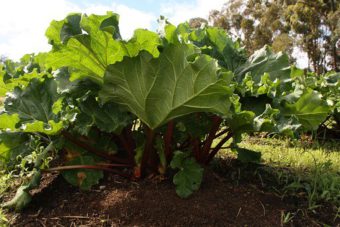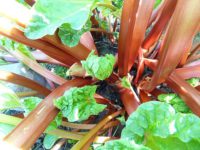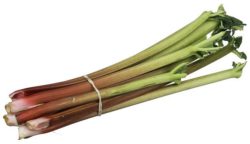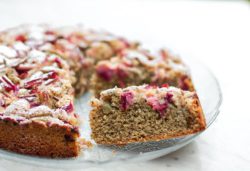In this article, we will be discussing the possibilities of growing rhubarb in containers. In a previous article, soft fruits that can be grown in containers were discussed, but no mention of rhubarb was made. It was not that I was amiss but because I felt that a future article was needed to explain in detail about growing rhubarb in containers.

The time has now arisen and because you cannot beat a good rhubarb pie, I am going to discuss the topic at hand now.
If you have seen a rhubarb plant in a garden, the first thing you notice is how big the plant is and secondly, how massive the leaves are. For a plant to do well it needs plenty of nutrients, fertilizers and water but it is not a difficult plant to grow in a container.
It is one of the easiest plants to look after and will continue to produce for many years. So if you have a love for rhubarb but you do not have the space to grow it in or you have no open ground to plant it in, then this beautiful perennial can be grown in a large container. Read on to find out how to.
CAN YOU GROW RHUBARB IN CONTAINERS?
If you thought that rhubarb was too big to grow in containers, then you are in for a surprise when you find out that you can. Larger plants mean larger containers. If you observe a rhubarb plant closely, you can see that the crown does not necessarily occupy too much growing area at the base.
This means that the width does not matter as much, but it is still a consideration as you want the crown to comfortably fit in the container. Width is a consideration but depth is much more important, as rhubarb has a deep root system.

If you think about growing rhubarb in containers. You want a container to be deep and wide as possible- A half-barrel is ideal. Something that has a depth and width greater than 0.5m is ideal. The larger the container is, the more room the plant has to grow and less watering will be required.
The container has to be sturdy and must have drainage holes in it to prevent the compost within the pot from becoming waterlogged. A waterlogged pot can result in the crown rotting and this is why drainage is an important consideration.
Now we know that rhubarb can be grown in containers, we need to discuss what rhubarb actually is?
WHAT IS RHUBARB?
Rhubarb or Rheum x cultorium to give its Latin name is a long-lived perennial that has thick, long, red, pink or green edible stalks. It is quite a cold tolerate plant and can take some frosts.
The green leaves that are produced at the top of each stalk are massive and make the plant look impressive. It can live for several years, 20 or more and still be productive.
The stalks, although sour makes excellent desserts and in savoury dishes, and much favour by professional chefs. Who does not like rhubarb pie or crumble with lashings of homemade custard?
GET THE GROWING MEDIA RIGHT
If you want to get the planting media right, it needs to be free-draining, so an equal mixture of 50% multipurpose compost and 50% horticultural grit will be ideal. Make sure that the bottom 10cm is covered with gravel to allow any excess water to drain away.

One thing that must be considered is that once a plant is placed in such a large container, it will be difficult to move. You need to place the plant in a position, where it will not need to be moved and is out if the way; it will be too heavy otherwise. If you want to move the container, the growing media can be made lighter, you can mix 50% compost with 50% perlite. The major drawback will be that it is more expensive to make.
To plant either beg a division from your friends or neighbours or buy a crown for planting in the container in early spring. Plant the division or crown 2.5 to 7.5cm deep, with the crown just below the surface. Firm the crown into the growing media and water very well.
Place the plant in a sunny location, where the natural water of the rain will keep the compost moist. Do not overwater as this can lead to root rot.
VARIETIES TO GROW
‘Champagne’ which has excellent flavour with thick, heavily, red-flush green stems.
‘Sanvitos Summer’ is a strong, vigorous plant which produces flushes of eye-catching, vivid red stems with a well-balanced acidity. The stems of this rhubarb are stringless.
‘Timperley Early’ is a very early variety. You can often pick a few slender stems in early spring and as late as August as well.
CARING FOR THE PLANT
Rhubarb tends to be easy to look after but in containers, extra attention needs to be considered. For example, a large root system would need extra water, and it is advised to water rhubarb in containers much more often, especially in long, dry spells. Give the plant enough water until it can be seen running out of the bottom of the container.
To help conserve water, it is better to use bark to mulch the surface of the container. Container grown rhubarb will need a feeding of a slow-release fertiliser once a year at the beginning of spring, where active growth is starting to occur. No more fertilizers need to be added after that. When you use fertilizers fork it in around the base of the plant and then water in.
It will take a while for the plant to establish, so during its first growing season, do not harvest any stalks. In the second year, only harvest a few stalks but leave the rest. From year 3 onwards, you can start harvesting in earnest when required, but always leave 4 stalks on the plant at one time.
HOW TO HARVEST THE PLANT

Harvest the stalks by gently pulling and twisting at the bottom of the plant, so that nothing of the stalk is left behind. This will prevent any rot from occurring. If any flowering stem is produced in spring, remove them as soon as they are observed, as they will take energy away from foliage and stem production.
The plant will die back in autumn, where the rotting stems should be removed. In late winter, new stalks should start emerging from the crown, so start making your rhubarb pie in spring.
Rhubarb needs to feel the chill to produce but excessive cold and rain can kill the crown, so you will need to mulch over them to protect the plant.
IT WILL EVENTUALLY NEED TO BE DIVIDED
After 5 years or so, the plant will get too big and will not be so productive. At this stage, it needs to be divided. It is best done in early spring, where a growing bud can be observed. All you need to do is place a spade through the root with the growing bud present in the division.
The division can then be planted straight away in another container. Repeat this with other growing buds until the original crown is greatly reduced, Refill with extra compost and the plant will do much better in the preceding years. From one plant, you may make 3 to 4 division for free, so a great investment. Do not harvest leaves after July and the plant needs time to recover and conserve its energy for next year’s growth.
Look out for dull, lifeless foliage with small, sickly stems and the growth buds dying off; this is the symptoms of crown rot. There is no cure, remove and destroy affected plants and get rid of the compost, clean the container and place new growing media and plant a new, healthy plant.
CONCLUSIONS
In this article, we have discussed how to grow rhubarb in containers. We have discussed it is not a difficult as it seems. All you need to do is find the right containers, water it well, feed it and divide it when necessary. If you follow all of these requirements, you will have rhubarb for many years to come.
If you have any questions or comments, you wish to make, please do so in the comment box below.
Happy rhubarb growing.

I grew up with rhubarb growing in our garden. The garden at my parents’ place is big and we had a lot of rhubarb every year. My mum used to make a lot of very nice dishes from the rhubarb.
Where my wife and I are living at the moment, we don´t have a lot of space, but the option to grow rhubarb in a container was new to me. Your article makes me want to try it. So I am going shopping at the weekend and plant rhubarb. Your tips and explanations on what to be careful about are very good information to new “rhubarb farmers”. I did in fact not know that the plant also tolerates some frost, but thinking back to my childhood, I remember that we covered up the rhubarb just before the snow started falling.
Hi Roy
Rhubarb is not only good to eat but very pleasing to the eye and to a lot of people without garden think they cannot grow them but they can. As long as you provide a big enough growing space, feed it and water it. Mulch is recommended to prevent crown rot, a deadly disease of rhubarb. I hope you give it a go.
Thanks
Antonio
Hello,
This was a really interesting article.
I never knew that Rhubarb could grow in containers. This would be very helpful for those with small gardens, patios or balconies.
You provided very clear and helpful instructions on how to do this and what to avoid.
Rhubarb is very versatile and can be used for both jam and chutney.
Best wishes,
Cameron
Hi Cameron
It is surprising to what can grow and not be grown in containers, as often you think that rhubarb will be too big. Of you follow my article to the tee, you will be soon harvesting succulent stalks for your cooking.
Best wishes
Antonio
Wow, I haven’t eaten rhubarb for years, as you just never find it, and reading this article brought back great memories. When I was growing up my gran at the farm always made rhubarb jam and also our favorite – rhubarb pudding.
Reading this article I think I must attempt to add this to our growing veggie garden and see if it can do well, as I wouldn’t mind trying out those recipes again to see if I can recreate the memories for my own daughter.
Hi Michel
It is always good to have a trip down memory lane and rhubarb is such a treat. You should grow rhubarb to show your daughter on how it is done and if you follow my tips, you will succeed.
Thanks
Antonio
Since it needs the cold is it possible to grow in southern Arizona where we rarely drop below freezing?
Hi Kent
In places that do not get frosts it is best to grow them as annuals from seed. Growing new plants every year. otherwise it will fail miserably.
Thanks
Antonio